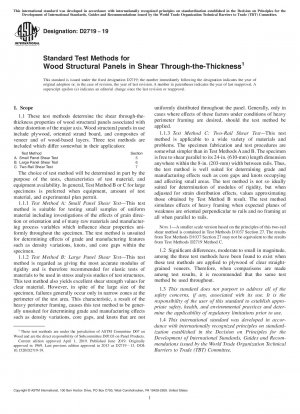ASTM D2719-19
Standard Test Methods for Wood Structural Panels in Shear Through-the-Thickness
- Standard No.
- ASTM D2719-19
- Release Date
- 2019
- Published By
- American Society for Testing and Materials (ASTM)
- Latest
- ASTM D2719-19
- Scope
- 1.1 These test methods determine the shear through-thethickness properties of wood structural panels associated with shear distortion of the major axis. Wood structural panels in use include plywood, oriented strand board, and composites of veneer and of wood-based layers. Three test methods are included which differ somewhat in their application: Test Method Section A. Small Panel Shear Test 5 B. Large Panel Shear Test 6 C. Two-Rail Shear Test 7 The choice of test method will be determined in part by the purpose of the tests, characteristics of test material, and equipment availability. In general, Test Method B or C for large specimens is preferred when equipment, amount of test material, and experimental plan permit. 1.1.1 Test Method A: Small Panel Shear Test—This test method is suitable for testing small samples of uniform material including investigations of the effects of grain direction or orientation and of many raw materials and manufacturing process variables which influence shear properties uniformly throughout the specimen. The test method is unsuited for determining effects of grade and manufacturing features such as density variations, knots, and core gaps within the specimen. 1.1.2 Test Method B: Large Panel Shear Test—This test method is regarded as giving the most accurate modulus of rigidity and is therefore recommended for elastic tests of materials to be used in stress analysis studies of test structures. This test method also yields excellent shear strength values for clear material. However, in spite of the large size of the specimen, failures generally occur only in narrow zones at the perimeter of the test area. This characteristic, a result of the heavy perimeter framing, causes this test method to be generally unsuited for determining grade and manufacturing effects such as density variations, core gaps, and knots that are not uniformly distributed throughout the panel. Generally, only in cases where effects of these factors under conditions of heavy perimeter framing are desired, should the test method be applied. 1.1.3 Test Method C: Two-Rail Shear Test—This test method is applicable to a wide variety of materials and problems. The specimen fabrication and test procedures are somewhat simpler than in Test Methods A and B. The specimen is free to shear parallel to its 24-in. (610-mm) length dimension anywhere within the 8-in. (203-mm) width between rails. Thus, the test method is well suited for determining grade and manufacturing effects such as core gaps and knots occupying and affecting small areas. The test method is not so ideally suited for determination of modulus of rigidity, but when adjusted for strain distribution effects, values approximating those obtained by Test Method B result. The test method simulates effects of heavy framing when expected planes of weakness are oriented perpendicular to rails and no framing at all when parallel to rails. NOTE 1—A smaller scale version based on the principles of this two-rail shear method is contained in Test Methods D1037 Section 27. The results from Test Methods D1037 Section 27 may not be equivalent to the results from Test Methods D2719 Method C. 1.2 Significant differences, moderate to small in magnitude, among the three test methods have been found to exist when these test methods are applied to plywood of clear straightgrained veneers. Therefore, when comparisons are made among test results, it is recommended that the same test method be used throughout. 1.3 This standard does not purport to address all of the safety concerns, if any, associated with its use. It is the responsibility of the user of this standard to establish appropriate safety, health, and environmental practices and determine the applicability of regulatory limitations prior to use. 1.4 This international standard was developed in accordance with internationally recognized principles on standardization established in the Decision on Principles for the Development of International Standards, Guides and Recommendations issued by the World Trade Organization Technical Barriers to Trade (TBT) Committee. 1 These test methods are under the jurisdiction of ASTM Committee D07 on Wood and are the direct responsibility of Subcommittee D07.03 on Panel Products. Current edition approved April 1, 2019. Published June 2019. Originally approved in 1969. Last previous edition approved in 2013 as D2719 – 13. DOI: 10.1520/D2719-19. Copyright © ASTM International, 100 Barr Harbor Drive, PO Box C700, West Conshohocken, PA 19428-2959. United States This international standard was developed in accordance with internationally recognized principles on standardization established in the Decision on Principles for the Development of International Standards, Guides and Recommendations issued by the World Trade Organization Technical Barriers to Trade (TBT) Committee. 1 2. Referenced Documents
ASTM D2719-19 Referenced Document
- ASTM D1037 Standard Test Methods for Evaluating Properties of Wood-Base Fiber and Particle Panel Materials
- ASTM D2395 Standard Test Methods for Specific Gravity of Wood and Wood-Based Materials
- ASTM D4442 Standard Test Methods for Direct Moisture Content Measurement of Wood and Wood-Base Materials
ASTM D2719-19 history
- 2019 ASTM D2719-19 Standard Test Methods for Wood Structural Panels in Shear Through-the-Thickness
- 2013 ASTM D2719-13 Standard Test Methods for Structural Panels in Shear Through-the-Thickness
- 2007 ASTM D2719-89(2007) Standard Test Methods for Structural Panels in Shear Through-the-Thickness
- 1989 ASTM D2719-89(2001)e1 Standard Test Methods for Structural Panels in Shear Through-the-Thickness
- 1989 ASTM D2719-89(2001) Standard Test Methods for Structural Panels in Shear Through-the-Thickness
- 1989 ASTM D2719-89(1994)e1 Standard Test Methods for Structural Panels in Shear Through-the-Thickness
